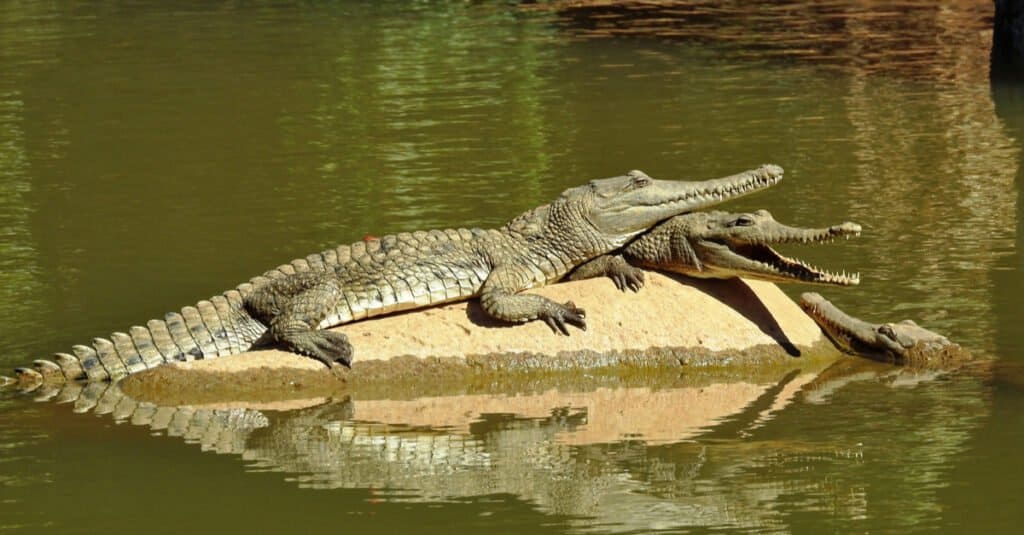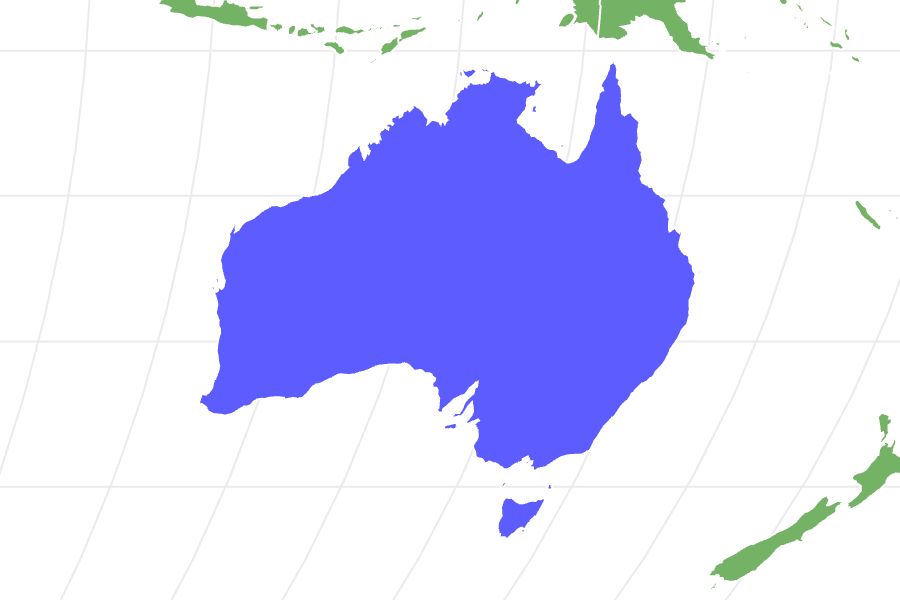Freshwater Crocodile
Crocodylus johnstoni
The freshwater crocodile is the fastest crocodile on land.
Advertisement
Freshwater Crocodile Scientific Classification
- Kingdom
- Animalia
- Phylum
- Chordata
- Class
- Reptilia
- Order
- Crocodilia
- Family
- Crocodylidae
- Genus
- Crocodylus
- Scientific Name
- Crocodylus johnstoni
Read our Complete Guide to Classification of Animals.
Freshwater Crocodile Conservation Status
Freshwater Crocodile Facts
- Prey
- Insects, fish, crustaceans, spiders, lizards, birds, snakes, frogs, turtles, bats and small mammals.
- Name Of Young
- Hatchling
- Group Behavior
- Social
- Fun Fact
- The freshwater crocodile is the fastest crocodile on land.
- Estimated Population Size
- Less than 100,000 but its conservation status is least concern.
- Biggest Threat
- Cane toads, habitat destruction
- Most Distinctive Feature
- Its narrow snout
- Other Name(s)
- Freshie, Johnstone’s crocodile, Australian freshwater crocodile, Johnstone River Crocodile, Johnson's Crocodile, Johnstone's Crocodile
- Gestation Period
- 65 to 95 days
- Litter Size
- 13 to 20
- Habitat
- Rivers, billabongs, swamps, lagoons, other bodies of fresh water
- Predators
- Feral pigs and monitor lizards eat the eggs, olive pythons may eat smaller individuals
- Diet
- Carnivore
- Type
- Reptile
- Common Name
- Freshwater crocodile
- Number Of Species
- 1
- Location
- Northern Australia
- Group
- Bask, nest
Freshwater Crocodile Physical Characteristics
- Color
- Grey
- Dark Brown
- Dull Olive
- Light-Brown
- Skin Type
- Plate-like scales
- Top Speed
- 10.56 mph
- Lifespan
- Lifespan usually 40 to 60 years but some have reached 100 years
- Weight
- 159 pounds for males, 88 pounds for females
- Length
- 7.5 to 9.75 feet for males, 6.9 feet for females
- Age of Sexual Maturity
- 17 to 20 years for males, 15 to 20 years for females
View all of the Freshwater Crocodile images!
“The Freshwater Crocodile can be described as ‘Almost harmless’.”
Despite the fact that it can grow to about 9 feet and has about 70 teeth that are always being replaced, the freshwater crocodile is not that much of a danger to human beings. This can’t be said for its huge cousin the saltwater crocodile. The freshie, on the other hand, is content to bask in the sun and chow down on its favorite food, insects. Read on for more information on this laid-back crocodilian.
Five Amazing Facts
Here are five amazing facts about the Australian freshwater crocodile:
- A male freshie is called a bull, but the female is not necessarily a cow. The baby crocodile is a hatchling.
- As with many other reptiles, the sex of a baby crocodile is determined by the temperature at which its egg is incubated. Males are produced between 89.6 degrees Fahrenheit while females are produced between 91.4 and 93.2 degrees F.
- Freshies are pulse nesters. This means all the females in an area make their nests within a three week period during the breeding season.
- In Australia it is actually legal to keep a freshwater crocodile as a pet as long as the person has a permit, and the reptile is less than 1.97 feet long. It is even legal to keep a saltwater crocodile as a pet, even though these beasts have humans as part of their diet.
- Sexual maturity isn’t so much determined by age as by size. Freshies are ready to mate when they’re about 4.9 feet long.
Freshwater Crocodile Scientific Name
The freshie’s scientific name is, properly Crocodylus johnstoni. Crocodylus is Latin for “crocodile,” and johnstoni comes from the person who first reported the animal to the zoologist Gerard Krefft, Robert Johnstone. The epithet of johnsoni is, therefore, a mistake, even though a synonym for the freshie is still C. johnsoni. There are no subspecies.
Freshwater Crocodile Appearance
Most freshies don’t grow much more than 9 feet long. It has a crocodile’s V-shaped snout, all of its 68 to 72 teeth are visible when it closes its mouth, and it replaces its teeth throughout its life. A more slender snout than its cousin the saltwater crocodile and smaller teeth are two traits that help with the identification of this crocodile.
The colors of the body are light brown with darker bands that stretch from the neck to the tail. Some crocodiles may have dark mottling or bands on their snout. The scales are large and there are scutes on the back and pebble-like scales on the animal’s legs and flanks. It has four feet that are webbed and help the animal make sharp, fast turns in the water. Like other reptiles, the freshie is coldblooded. It doesn’t sweat but opens its mouth and pants to expel heat from its body. Its senses are keen and its ears, eyes and nostrils are on the top of its head, which allows it to see, smell and hear even when it’s nearly submerged. The crocodile also has excellent night vision, which gives it an advantage over prey whose night vision isn’t as sharp.

©Kirsty Nadine/Shutterstock.com
Freshwater Crocodile vs Saltwater Crocodile
Besides the narrower snout and smaller teeth, one aid in the identification of the Australian freshwater crocodile versus the saltwater crocodile is that the freshie is much smaller. A male saltwater crocodile, whose scientific name is Crocodylus porosus can grow to 20 feet and weigh over a ton. Even the female, who is half that length, is longer than a typical male freshie. The freshwater crocodile feeds largely on small animals, including insects, but the sheer size and power of a saltie makes it able to handle larger mammals, including human beings.
The colors of the freshie and the saltie are also different. In contrast to the freshie’s light brown ground color with darker brown stripes, the colors of the saltie are sort of olive green with areas of gray or tan. Their colors are other aids in the identification of these two crocodiles.
Human beings have been bitten by freshies, but there are no reported deaths. Human deaths in the jaws of a saltwater crocodile may be uncommon but they do happen, as the saltie sees a human as just another prey animal. The bite force of a saltie can be as high as 11,216 Newtons. This gives the saltwater crocodile the most powerful bite force in the animal world. By contrast, the weakest bite force among the crocodiles was 436 Newtons from a freshie.
Freshwater Crocodile Behavior
Though freshwater crocodiles can’t be said to be convivial, they do tolerate being in each other’s presence. They often bask together and are not territorial. They are active in the daytime when the sun warms them, but they hunt at night. A freshie usually sits and waits for its prey to come within striking distance, then it whips its head to the side and grabs the prey in its jaws. The prey is usually surprisingly small, though the crocodile has been known to take wallabies. This may be because its bite force is not very strong. If prey is larger, the crocodile may stalk it.
Freshwater Crocodile Habitat
As their name suggests, freshies are found in freshwater habitats such as rivers, creeks, swamps, and lagoons, though they can sometimes be found in intertidal areas of rivers surprisingly close to saltwater crocodiles. Freshies are only found in northern Australia, and some have even been seen around Katherine Gorge, whose water levels are quite low during the dry season.
Freshwater Crocodile Diet
Freshies have a variety of small animals as part of their diet. They include invertebrates such as insects, crayfish and other crustaceans. They also eat fish, spiders, other reptiles such as turtles and snakes as well as bats and birds. Insects seem to be the crocodile’s preferred prey.
Freshwater Crocodile Predators and Threats
A fully grown freshwater crocodile has few predators save humans, and hunting them has been outlawed. They are still raised on farms for their hides which are turned into leather. They’re also raised for meat and eggs. The greatest threat to the freshie is habitat destruction and the cane toad. The cane toad is not only an invasive species, it is poisonous, unlike the other toads that the crocodile eats. The crocodile is also vulnerable to a parasite called Griphobilharzia amoena, which invades the animal’s circulatory system and eats its blood. Poachers also take freshwater crocodiles.
Freshwater Crocodile Reproduction and Life Cycle
The breeding season of the Australian freshwater crocodile coincides with the dry season in Australia, which is July through August. After mating, the female is gravid for about a month before she lays her eggs. She can lay 13 to 20 eggs in a nest hole on a sandbar. She won’t defend the nest, but she’ll return to it when she hears the babies inside the eggs start to call. This happens about one to five days before the eggs actually hatch at the end of October. The calls are a signal for the mother to open up the nest, and if a baby is having trouble getting out of the egg, she may gently crack it with her teeth. When the babies hatch she just as gently picks them up in her mouth and takes them down to the water. After that, the mother guards the hatchlings for a while. If a hatchling survives, it can have a lifespan of 60 to 70 years or more.
Freshwater Crocodile Population
There are about 100,000 freshies in the wild, and their conservation status is least concern.
View all 91 animals that start with FFreshwater Crocodile FAQs (Frequently Asked Questions)
Are Freshwater Crocodiles carnivores, herbivores, or omnivores?
Freshwater crocodiles are carnivores and predators, but they take surprisingly small prey.
What preys on a freshwater crocodile?
Humans prey on freshies, and wild pigs and monitor lizards dig up and eat the eggs. Olive pythons have also been known to eat freshies after a struggle.
Which is larger saltwater or freshwater crocodile?
The saltwater crocodile is much larger than the freshwater crocodile. The saltie can grow to 20 feet and weigh a ton, and even a large freshie is about half that length and not even a tenth of its weight. The saltie also has a bite force that is multiples stronger than the freshies.
What happens if you put a live freshwater crocodile in saltwater?
Freshies can actually tolerate swimming in and living around bodies of saltwater. The main problem is this puts them in proximity to saltwater crocodiles who don’t tolerate them very well.
Why is the Philippine freshwater crocodile endangered?
This critically endangered crocodile is in trouble because of habitat destruction and wanton killing by natives who are afraid of it. However, the Philippine freshwater crocodile is small and inoffensive. There are only about 100 adult members of this species in the wild.
Is it safe to swim with freshwater crocodiles?
If you are determined to swim with freshwater crocodiles it is probably safe, but they have been known to mistake a human for prey and bite. No one has been killed by a freshie, but their bites are nasty and need to be seen to.
Are freshwater crocodiles aggressive?
Freshwater crocodiles are not particularly aggressive toward humans. They can even be kept as pets until they grow too large.
Thank you for reading! Have some feedback for us? Contact the AZ Animals editorial team.
Sources
- Northern Territory Government information and services, Available here: https://nt.gov.au/environment/animals/keeping-wildlife-as-pets/keeping-crocodiles/how-to-keep-a-crocodile
- Wikipedia, Available here: https://en.wikipedia.org/wiki/Freshwater_crocodile
- ITIS, Available here: https://www.itis.gov/servlet/SingleRpt/SingleRpt?search_topic=TSN&search_value=551774#null
- Guinness World Records, Available here: https://www.guinnessworldrecords.com/world-records/93335-fastest-crocodile-on-land
- Christchurch City Council Libraries, Available here: https://my.christchurchcitylibraries.com/animal-names/
- Guinness World Records, Available here: https://www.guinnessworldrecords.com/world-records/400475-weakest-caniniform-bite-force-for-a-crocodile
- Billabong Sanctuary, Available here: https://www.billabongsanctuary.com.au/freshwater-crocodile/
- Queensland Department of Environment and Science, Available here: https://environment.des.qld.gov.au/wildlife/animals/living-with/crocodiles/about-crocodiles/freshwater

















